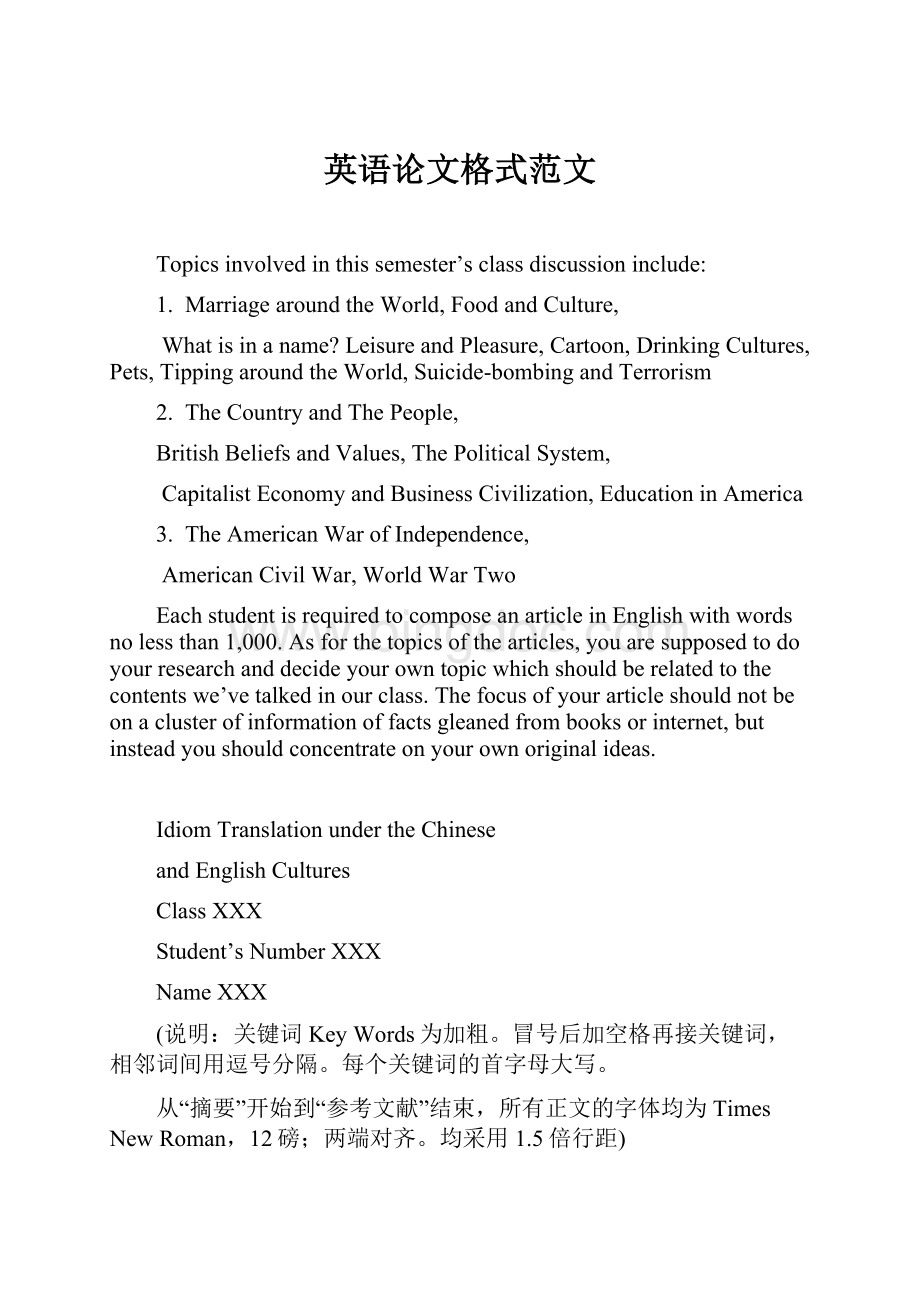英语论文格式范文.docx
《英语论文格式范文.docx》由会员分享,可在线阅读,更多相关《英语论文格式范文.docx(8页珍藏版)》请在冰点文库上搜索。

英语论文格式范文
Topicsinvolvedinthissemester’sclassdiscussioninclude:
1.MarriagearoundtheWorld,FoodandCulture,
Whatisinaname?
LeisureandPleasure,Cartoon,DrinkingCultures,Pets,TippingaroundtheWorld,Suicide-bombingandTerrorism
2.TheCountryandThePeople,
BritishBeliefsandValues,ThePoliticalSystem,
CapitalistEconomyandBusinessCivilization,EducationinAmerica
3.TheAmericanWarofIndependence,
AmericanCivilWar,WorldWarTwo
EachstudentisrequiredtocomposeanarticleinEnglishwithwordsnolessthan1,000.Asforthetopicsofthearticles,youaresupposedtodoyourresearchanddecideyourowntopicwhichshouldberelatedtothecontentswe’vetalkedinourclass.Thefocusofyourarticleshouldnotbeonaclusterofinformationoffactsgleanedfrombooksorinternet,butinsteadyoushouldconcentrateonyourownoriginalideas.
IdiomTranslationundertheChinese
andEnglishCultures
ClassXXX
Student’sNumberXXX
NameXXX
(说明:
关键词KeyWords为加粗。
冒号后加空格再接关键词,相邻词间用逗号分隔。
每个关键词的首字母大写。
从“摘要”开始到“参考文献”结束,所有正文的字体均为TimesNewRoman,12磅;两端对齐。
均采用1.5倍行距)
Abstract:
Nida,afamoustranslator,says,"Fortrulysuccessfultranslation,itismuchmoreimportanttofamiliarizetwoculturesthanmastertwolanguages,becausewordsareassignedmeaningsinitsparticularcultures."(Backgroundinformation)Thisistosay,translationiscloselyrelatedwithnotonlylanguagesbutalsocultures.StudiesoftheculturaldistinctioninidiomtranslationarestillrelativelyweakinthefieldoftranslationinChina.ExclusiveresearchonthetranslationofChineseandEnglishidiomsisstillincomplete.Inthelasttwentyyears,idiomtranslationhasmostlyemphasizedthelevelofinter-lingualcommunication,butculturaldifferenceswererarelyinvolvedinit.(Identifyproblem)ThisthesisanalysestheculturaldifferencesinChineseandEnglishidioms,thenstudiesEnglish-Chinese\Chinese-Englishidiomtranslationmethods(Researchsubject)fromtheangleofculture(Method)andpointsoutsomewarningsconcerningidiomtranslation:
payattentiontocontextandchoosetherightversioninlinewiththestyleandmeaningoftheoriginalpassage(Results);cultureisawholewayoflife,whennewcultureemerges,newidiomsalsoappear,thereforeidiomtranslationshoulddevelopwiththetime.(Conclusion)
KeyWords:
idioms;culture;translation
1.Introduction
Idiomsuniversallyexistineverylanguage.AnIdiomisawordoranexpressionthatcannotbeliterallytranslatedfromthesourcelanguageintothetargetlanguagebecauseitsidiomaticmeaningcannotbeunderstoodbyliterallydefiningitscomponentparts.(Background)Inabroadsense,idiomscontainsetphrases,proverbs,colloquialisms,slangs,maxims,allusions,etc.(YinLi,2007:
9)InChinese,theyalsoincludeenigmaticfolksimiles.Newmark,aBritishtranslationtheorist,inhisworkATextbookofTranslation,said,"Idefineasculturethewayoflifeandhismanifestationthatarepeculiartoacommunitythatusesapeculiarlanguageasitsmeansofexpression."(Previousresearch)EnglishIdiomsderivesfromEnglishculturesanddailylife.Inrealcontext,idiomsexplainthemselves:
ninetimesoutoftentheycarrytheirownexplanations.Ifweareunawareofthese,wewillfindourselvesinastateofconfusionsincewewillassignliteralmeaningtothem.TheChineseIdioms,especiallythefour-characteridioms,havetheirownuniqueoriginswhicharecloselycorrelativetotheChinesehistoryandcultures.Inviewofthedifficultiesinunderstandingidioms,weshouldpaydueattentionandeffortstounderstandtheirculturesandcustoms.ThisthesisisdesignedtodigintotheculturaldifferencesbetweenChineseandEnglishandthenelaboratesonthetranslationtheoriesappliedtoidioms.(Subject+Method)
2.AComparisonBetweenEnglishandChineseIdioms
2.1TheCulturalDifferencesBetweenEnglishandChineseIdioms
2.1.1GeographicalConditions
Theformationofcultureiscloselyrelatedwithnaturalgeographicalconditions.Aspecificgeographicalenvironmentproducesaspecificculture,whichalsoleadstoaparticularexpression.
GreatBritaincoversislandsincludingtheNorthernone-sixthoftheislandofIrelandbetweentheNorthAtlanticOceanandtheNorthSea,northwestofFrance.Ithasamoistclimatewithmuchrainfall.Riversandlakesarenumerous.NowonderthatfisheryisthrivingandmostimportantinBritain.Accordingly,idiomsconcerningfishandnavigationconstituteagreatpartinEnglishidioms.(LiYuping,2008:
20)(Theory/Resultsofpreviousresearch)
Forexample,"likeafishoutofwater".Ifyoufeellikefishoutofwater,youfeelawkwardanduncomfortablebecauseyouareinanunusualandunfamiliarsituation.
Fishintheair缘木求鱼
Anoddfish怪人
Misstheboat错过机会
Trimthesailstothewind顺势前进
Asmallleakwillsinkagreatship小洞不补要沉大船(Examples)
Ontheotherhand,ChinaislocatedintheAsianContinentandreputedasanagriculturalcountrywithalargepopulationofpeasants.Itisnotsurprisingtofindmanyidiomsrelevanttofarming,suchas"骨瘦如柴,对牛弹琴,众人拾柴火焰高,竹篮打水一场空......".Chinesepeoplealsohaveamysteriousandawefeelingforsea,sotheyhaveidiomslike"海角天涯,海枯石烂,海阔天空,海底捞针,海市蜃楼......".(Analysis)
2.1.2History
……………………………………………………………………………….
……………………………………………………………………………….
……………………………………………………………………………….
2.2TheSimilaritiesBetweenEnglishandChineseIdioms
……………………………………………………………………………….
……………………………………………………………………………….
……………………………………………………………………………….
2.2.1Colours
……………………………………………………………………………….
……………………………………………………………………………….
……………………………………………………………………………….
……………………………………………………………………………….
2.2.2Numbers
……………………………………………………………………………….
……………………………………………………………………………….
……………………………………………………………………………….
3.MethodsofIdiomTranslation
Translationisfarmorethanascience.Itisalsoaskill,andattheultimateanalysis,fullysatisfactorytranslationisalwaysanart.(Nida,1982:
49)Translationisconsideredastheculturalbridgeandmediabetweentwolanguages.AstherearewidedifferencesinvocabularyandsyntaxbetweenEnglishandChinese,translationisnoeasyjob.Therefore,inordertokeeptheflavoroftheoriginalaswellascaterforboththeChineseandEnglishlanguages,translationskillsshouldbereasonablyemployedintheprocessoftranslating,suchasthefollowingtranslatingmethods:
3.1LiteralTranslation
……………………………………………………………………………….
……………………………………………………………………………….
……………………………………………………………………………….
3.2FreeTranslation
……………………………………………………………………………….
……………………………………………………………………………….
……………………………………………………………………………….
3.3TranslationwithNotes
……………………………………………………………………………….
……………………………………………………………………………….
……………………………………………………………………………….
3.4ReplacementwithSimilarIdioms
……………………………………………………………………………….
……………………………………………………………………………….
……………………………………………………………………………….
3.5TheTranslationofCorrespondingIdiomswiththeSameMeaning
……………………………………………………………………………….
……………………………………………………………………………….
……………………………………………………………………………….
3.6ACombinationofLiteralandFreeTranslation
……………………………………………………………………………….
……………………………………………………………………………….
……………………………………………………………………………….
4.SomeWarningsConcerningIdiomTranslation
……………………………………………………………………………….
……………………………………………………………………………….
……………………………………………………………………………….
5.Conclusion
Oneofthemajorcharacteristicsidentifyingusashumanisourabilitytouselanguage.Languageplaysaveryimportantroleinpeople’sdailylife;itenablespeoplecommunicatewitheachotherandunderstandothers'feelings.Languagehascloserelationswithculture.Itisimpossibletoseparatelanguagefromculture.Astheessenceoflanguage,idiomsalsohavecloserelationswithculture.Thecontentsofthemrangefromsociety,history,psychologytocustomsandothervarioussocialphenomena.So,intheprocessoftranslation,translatorsshouldpaymoreattentiontotheculturalfactors,indoingthis,hecandiguptheimplicitmeanings.(Conclusionofresearch)Onlytheculturalfactorsareconcerned,translatorscanhaveasatisfactorytranslation.Besides,peopleshouldgetacquaintanceswiththeculturalbackgroundwhenusingidiomstoavoidembarrassmentincommunication.(Suggestions)
References
[*]作者.书名(英语的斜体).(出版地:
)出版社,年份:
参考内容页码
[*]作者.文章名(英语的斜体).刊物名称.(出版地:
)出版社,年份
[1]LiMei.Mothertongueandtranslation.Shanhai:
ShanhaiForeignLanguageEducationPress,2008
[2]LiQingming.AComparisonoftheCulturesbetweentheChineseandEnglishLanguage.Xi'an:
NorthwestUniversityoftechnologyPress,2007
[3]NidaEugene.ThetheoryandPracticeofTranslation.Leiden:
E.J.Brill,1982
[4]NidaEugene.Language,Culture,andTranslating.Shanhai:
ShanhaiForeignLanguageEducationPress,1993
[5]SusanBassnett,AndreLefevere.Translation,History,Culture.Shanghai:
ShanhaiForeignLanguageEducationPress,1987
[6]LuoShiping.AResearchonEnglishIdioms.Shanhai:
ShanhaiForeignLanguageEducation
Press,2006
[7]LiYuping.EnglishIdiomsandtheirCulturalOrigin.Tianjin:
NankaiUniversityPress,2008
[8]YinLi.English-ChineseIdiomsandFolkCulture.Beijing:
BejinguniversityPress,2007
[9]ZhangYajun.AKaleidoscopeofChineseCulture.Beijing:
Sinolingua,2008\
[10]李云(LiYun).《新编大学翻译教程》.北京:
世界知识出版社,2007
[11]马爱英(MaAiying).《中英文化翻译》.北京:
科学出版社,2006
[12]孙致礼(SunZhili).《新编英汉翻译教程》.上海:
上海外语教学出版社,2008
[13]王宗炎(WangZongyan).《英汉语文问题面面观》.北京:
北京高等教育出版社,2006
[14]Informationon
英文论文撰写格式说明
1.论文电子版制作均采用MS-Word软件
2.页面设置(操作—点击“文件”里的“页面设置”进行)
1)新建WORD文档,选用A4纸并进行如下页面设置:
2)页边距:
上3cm,下1.7cm,左2cm,右2cm,装订线0cm。
3)版式:
页眉1.25cm,页脚0.5cm。
4)文档格式:
请在“网格”里选用“无网格”项。
5)行距:
1.5倍行距。
6)段落起始缩进三个英文字符。